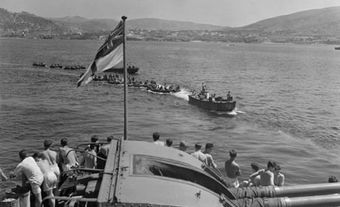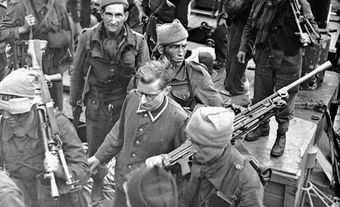In December 1943, as part of the Allied advance through Italy during the Second World War, Canadian forces fought one of their toughest battles of the war in a bid to capture the town of Ortona. The month-long campaign — first at the Moro River outside Ortona, then with vicious street fighting in the town itself — cost more than 2,300 Canadian casualties, but eventually won Ortona for the Allies.

| Battle of Ortona | |
| Date | 20–28 December 1943 |
| Location | Ortona, Italy |
| Participants |
Canada
Germany |
| Canadian Casualties (approximate) |
2,300 in total
500 killed |

The Battle for Ortona (inset) and the Adriatic Sector, 28 November 1943 to 4 January 1944.
(Source: Gerald W. L. Nicholson, The Canadians in Italy 1943-1945 (1956), Map 11, Department of National Defence)
Italian Campaign
Allied forces, including Canadians, had invaded Italy in July 1943, opening up a new front in southern Europe. First came the capture of the island of Sicily, followed by a slow advance up the boot of mainland Italy.
By the fall of 1943, the advance had bogged down in the face of determined German resistance, anchored on two defensive positions – the Gustav Line to the west and the Bernhard Line in the east. The Gustav Line hinged on the high point of Monte Cassino, while the Bernhard Line stood behind the Sangro River. Between these two lines lay the militarily impossible mountains of the Apennines.
In early November, British Eighth Army’s Major General Bernard Montgomery decided that a bold advance up the Adriatic coast could enable a left hook from the town of Pescara inland to Rome. He envisioned seizing the Italian capital before Christmas. Arriving at the Sangro River, the British won a small bridgehead on 24 November. Despite heavy casualties, on 28 November, Eighth Army launched a major attack to breakout of its bridgehead. A two-day fight to win a strategic ridge overlooking the river ensued that cost 2,800 British, New Zealand and Indian casualties.
Moro River
The Germans withdrew to the next river — the Moro — and dug in for another round. On the night of 5–6 December, the 1st Canadian Infantry Division and 1st Canadian Armoured Brigade took over Eighth Army’s lead and drew the job of forcing a crossing of the Moro. In the early morning hours of 6 December, a three-pronged attack began. Only the Princess Patricia’s Canadian Light Infantry (PPCLI) made headway, winning Villa Rogatti on the left flank. When engineers were unable to erect a bridge across the Moro to enable tanks to support the PPCLI, a withdrawal was ordered.
It took until 9 December for the Canadians to win a firm bridgehead. They expected to follow this with a quick advance around the flank of Ortona, a port and fishing town on the Adriatic Sea. The Canadians did not expect that the Germans would make a stand at Ortona.
The biggest battle that we had was the Battle of Ortona, where we lost a lot of men. At that point in time, I was running … a 2-inch mortar* crew. … When they formed up as a group, that’s when the enemy opened fire. We lost most of our platoon right there. … my objective was safe because we were further back, out of gun range. But out of all of them, there was about only three or four who survived, so we had lost very heavily on that particular battle. (Veteran George F. Burrows of the Canadian army, recalling the Battle of Ortona. Click here to listen to Burrows’ interview with The Memory Project.)
The Gully
Two days of fighting brought the Canadians to what appeared on topographical maps as nothing but a narrow, minor gap about a kilometre south of Ortona. But as the leading troops approached, they discovered the line was actually a deep, narrow gully. The Germans had dug deep holes into its southern bank that protected them from artillery fire. When the shelling stopped, the Germans dashed up to the gully’s edge to fire their machine guns on the Canadian infantry advancing up a gradual slope through tangled vineyards and olive groves.
“The Gully,” as the Canadians dubbed it, proved impossible to break with the direct attacks ordered by 1st Division’s Major General Chris Vokes. Each attack by a single battalion was thrown back with heavy casualties. Drenching rain and falling temperatures added to the misery. The battleground mirrored the muddy no man’s land between opposing sides during the First World War.

Finally, on the night of 14–15 December, the Royal 22nd Regiment’s 81 men of “C” Company, commanded by Captain Paul Triquet, managed to outflank the gully. Supported by seven Ontario Regiment tanks, this tiny force fought through fierce German resistance to win a farmhouse called Casa Berardi. For four days, fighting raged around this small strongpoint before the Germans slunk away. For his valour, Triquet was awarded a Victoria Cross, the Commonwealth's highest award for military bravery.
Showing superb contempt for the enemy Captain Triquet went round reorganizing the remainder and encouraging them with the words ‘Never mind them, they can’t shoot’. Finally when enemy infiltration was observed on all sides shouting ‘There are enemy in front of us, behind us and on our flanks, there is only one safe place – that is on the objective’ he dashed forward and with his men following him, broke through the enemy resistance.
(Excerpt from the Victoria Cross citation for Captain Paul Triquet, London Gazette, no.36408, 6 March 1944)
Ortona
Unexpectedly, the German 1st Parachute Division only withdrew as far as Ortona. Suddenly, the Canadians were confronted with something for which they had no training — a street battle. The Germans had started preparing to defend Ortona on 12 December by using explosives to blow many houses apart to create piles of rubble into which they dug deep fighting positions. Mines were scattered throughout the town. By 19 December, all side streets were clogged with rubble.
Two large buildings were blown down to block a street called Corso Vittorio Emanuele, at the entrance to the square facing the town hall. The municipal hall’s clock was removed from its tower and a machine gun mounted in the opening. At dawn on 21 December, German engineers most likely demolished the tower adjacent to the Cattedrale San Tomasso so that the falling structure cleaved the cathedral dome in half.
As this destruction was being carried out, the Loyal Edmonton Regiment’s “D” Company was cut apart trying to fight its way into Ortona. Its 60 men were reduced to 17 in mere minutes. Despite these losses, the company’s survivors gained a foothold on the outskirts and were soon reinforced by other companies of their battalion. The Seaforth Highlanders of Canada and tanks of the Three Rivers Regiment also came alongside.
These two infantry battalions and a single tank regiment would carry the fight through the deadly labyrinth of Ortona in eight days of unrelenting battle. So intense was the street battle that war correspondents nicknamed Ortona “Little Stalingrad” because the fighting so resembled the definitive struggle in that Eastern Front city in Russia.
"Mouseholing" Tactics
Finding it suicidal to venture along the streets, the Edmontons and Seaforths resorted to “mouseholing.” Although taught in some British battle schools, none of the Canadians in Ortona had previously heard of this tactic. Instead, they invented it out of need. Explosives packed against the connecting wall of two buildings blasted an opening through which the soldiers chucked grenades and then followed through with a charge to clear any Germans on the other side.
As Ortona’s buildings were typically adjoining, the Canadians advanced from one to another while seldom venturing onto a street. It was a deadly game. At times, the Germans responded by setting demolitions that triggered when the Canadians burst through their mousehole. Sometimes an entire structure would collapse, burying the soldiers within.
Christmas
As the hand-to-hand struggle inside Ortona played out, two other Canadian brigades tried outflanking the town to the west. Success on this front would have forced the German paratroopers in Ortona to withdraw or be surrounded. The flanking attacks gained some initial headway before being blocked by the Germans.
Christmas Day brought no relief in the fighting either in Ortona or out on its western flank. On a western ridge, the 48th Highlanders were cut off and the supporting artillery officer could only save the situation by circling the Canadians within a ring of shellfire.
Inside Ortona, meanwhile, as Germans and Canadians traded bullets and grenades, the Seaforth’s quartermaster and headquarters staff organized a sumptuous Christmas dinner to which one company at a time was brought out of the line to be fed. The men of the Edmontons, however, had no reprieve. Their rations were delivered to the fighting lines.
Fall of Ortona
On 27 December, the CBC’s Matthew Halton reported that “the battle has the quality of a nightmare.” But it was a nightmare soon ended. The following morning, 28 December, an Edmonton patrol discovered that the paratroopers had pulled out quietly during the night—surrendering Ortona to the Canadians.

December’s fighting cost 2,339 casualties, including 502 killed — although the actual number of Canadians killed inside Ortona was never determined. German losses were also never calculated, but two divisions had been badly mauled between the Moro River and the end of the town battle. As Ortona had not been evacuated before the fighting started, many civilians were also killed and wounded. The most authoritative estimate sets civilian deaths at 1,314.
The town itself was a ruin that required years to rebuild. During the early winter months of 1944, despite its battle damage, Ortona served as a rest area for Canadian forces deployed a short distance to the north along the Arielli River.

 Share on Facebook
Share on Facebook Share on X
Share on X Share by Email
Share by Email Share on Google Classroom
Share on Google Classroom








